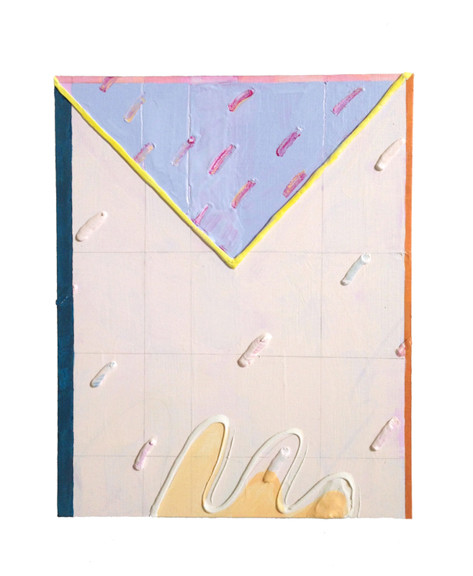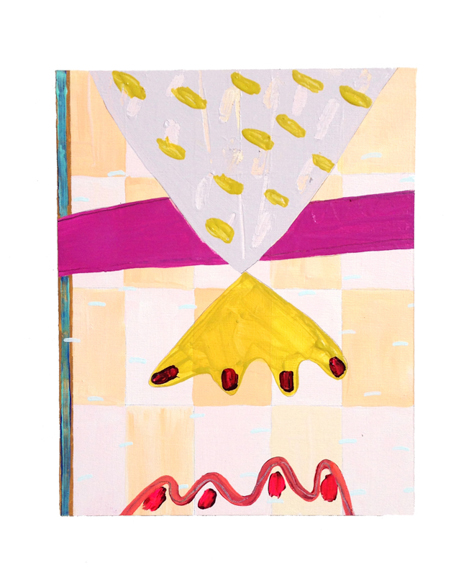Jessica Simorte
Jessica Simorte completed her MFA at the University of Cincinnati in 2014 is currently teaching at Sam Houston State University. She has shown regionally, locally and internationally and has been included in numerous esteemed publications. Simorte’s practice serves as an ongoing examination of how art making can function as a mode of placemaking. Having experienced topophilia her entire life, the work ultimately focuses on drawing and painting as a means of navigating physical and intangible places. She is represented by Galleri Urbane in Dallas, TX.
Statement
My work is an ongoing examination of how art making can serve as a mode of place making. My interests are primarily based in topophilia, and this bond between people and places powers my studio practice. Through painting, I am able to create environments that interest me in a manner that is suggestive but not specific – they are inside spaces, but beyond that, are ambiguous. I intend for the work to be transparent about my formal investigation and labor, but for the outcome to be indicative of a place that is playful and peculiar.
Making work with a strong sense of urgency and intuition allows for a sort of call-and- response for unexpected outcomes, resulting in work that feels both highly considered, and largely instinctual. My paintings are often made concurrently, developing clusters of work that quote each other and oftentimes remain together in exhibition. By looking at interiors through the filter of materials and physicality, the work ultimately focuses on drawing and painting as a means of navigating physical and intangible places.
Q&A with Jessica Simorte
by Emily Burns
Hi Jessica! Can you give us some insight into your process? How do you begin and how do you create your compositions? Does drawing play a part in your work initially?
Drawing plays a major role in my work in all stages. I work in a sketchbook regularly and that drawing often does inform the paintings, but not in a super direct way. Drawing feels as natural as painting to me, although there are formal differences between my work on paper and paintings on panel. It’s like how your handwriting changes when you use a different pen.
I mostly make small acrylic paintings. Until recently, I had focused on 8 x 10” panels. I did that for over a year. I also make work on paper and sometimes “paperclay drawings”, which are three dimensional versions of the motifs that are repeated most regularly in my paintings.
Can you talk more about Topophilia and how you became interested in it as a theme?
This is sourced from personal experience. I have, for as long as I can remember, been deeply interested in spatial experience. Phenomenology of space and place is a significant and inescapable part of human experience but is somewhat unconsidered in the day to day. Abstraction is the ideal way for me to address this, as I’m not interested so much in site specificity within the paintings, but rather, an environment that’s more cerebral, intangible, and ideal.
In your statement you mention that "Making work with a strong sense of urgency and intuition allows for a sort of call-and response for unexpected outcomes...” How did you discover this method of working? How does the perspective of going into your process potentially change the finished work, and have you experimented with alternate approaches?
I wasn’t always making paintings, so when I began exclusively painting in grad school I found that I had to do so quickly and unselfconsciously or else doubt would prevent any progress. My process now is certainly more thoughtful but with some of the same urgency as before. I base each move on the one that came previously— I trust my instincts and evaluate afterwards. This often results in just the right amount of awkwardness and hopefully, sincerity.
You mention interiors and environments in your statement—does the physical interior of the exhibition space affect this investigation in your work?
The eventual exhibition space doesn’t really affect the work as it’s getting made, as most of the work isn’t made for a specific show/environment. Often what ends up being more important is the setting in which the work gets made: the studio, the city I’m living in, etc.
Can you describe how making art acts as a form of placemaking for you? Can you make work anywhere?
This is sort of the problem that I’m always trying to solve, I guess. I’m trying to create these environments that are a combination of the real and the imaginary. These places (in the work) are satisfying in ways my real environments are not. The act of painting can feel similar to placemaking—you put something in a space, it’s not quite right so you take it out or move it over there, and you fuss until it feels right. I’ve lived and worked in a lot of different places and so far it hasn’t been an issue, but when I’m somewhere with a solid art community there’s more of a sense that I’m making the work for an audience. Some places can definitely make you feel like you are on an island, and that can be a hard environment to be motivated in.
What is a typical day like for you?
Quite different now than six months ago! I began teaching full time at a University in Texas this year, and it’s been an exciting and demanding change of pace. Every day feels quick and productive. Monday through Thursdays are spent at school, teaching and planning. Fridays are for meetings and catching up on applications and other computer work. Weekends are reserved for studio and cooking.
What are some of the biggest challenges that you have overcome as an artist so far in your career?
I haven’t begun to overcome my student loans, but they are detrimental when you’re trying to think about your practice as something long term. I often think what kind of work could I be making if I could rent a large studio? What risks would I be taking with the work if I weren’t so financially limited?
Can you describe your studio space? What are your most important workspace essentials?
My current studio set up is a modest spare bedroom. It suits the small work well and makes it easy to look over in-progress work before going in to teach, but I definitely dream of a bigger and better studio. I like to keep things organized and clean so that the time I do have to work can be spent painting and not looking for something. Essentials include angled shader brushes, Golden transparent acrylics and a 6” metal ruler I use all of the time.
What do you listen to while you work? Is this an important part of your practice?
Yes, there is always something playing. Sometimes I turn on podcasts but mostly music. I seem to get less distracted if there’s background noise. I don’t easily tire of music I love so my favorites get repeated almost every day.
Has there ever been a book/essay/poem/film/etc. that totally changed or influenced you? What are you reading right now?
Gaston Bachelard’s The Poetics of Space and Lucy Lippard’s The Lure of the Local were largely influential in helping me articulate my ideas. I’m currently reading One Hundred Years of Solitude and a fun novel named Mr. Penumbra’s 24-Hour Bookstore, which is a quicker read by comparison.
What are some of the artists that you look at and feel that your work is in dialogue with?
Among my favorite artists are Allison Miller, Rebecca Morris, and Betty Woodman—I suppose pattern could be the connection there. I respond to Ky Anderson’s work a lot, too. I think often about the overlap between painting and drawing and her work is, for me, an incredible example of this. I also really respect those that have thoroughly investigated small work: Etel Adnan, Forrest Bess, and Richard Tuttle.
Do you have any advice for recent grads that are looking for teaching jobs, transitioning out of graduate school, or looking to begin their career as studio artists?
I’m not an expert by any means and can only speak to my process. The year after grad school was spent working for the Kansas City Art Institute’s Continuing Ed program, substitute teaching K-12 and painting. I had things lined up in the studio that needed my attention, so I couldn’t wallow. I was grateful for the great opportunities coming my way and I took on everything I could until it felt like things were getting sacrificed.
In terms of teaching, you have to get experience where you can take it. Higher Ed is so competitive right now that you could be doing everything right and still not be getting anything. A lot of time and hard work go into applications each winter and you just never know, but you have to sincerely believe you have a chance. Be willing to move anywhere. I’ve done a lot of “starting from scratch.” Nurture the relationships you have because more often than not, that’s how things happen regardless of the niche. I can’t tell you how many times I can trace back a major opportunity to someone I met, it all seems to happen that way. Or Instagram—seriously.
2015 was a busy year for you! Can you talk a bit about how you stay involved and maintain a rigorous exhibition schedule?
I started 2015 working toward a March solo show with Galleri Urbane in Dallas and had another in Kansas City in July. This stretch was rigorous, but the momentum I had going was a great feeling, especially because I knew by fall I would be teaching and things would be very different. Other opportunities like working with Left Field, run by Nick Wilkinson in San Luis Obispo, CA, came from partnership that originated online. I worked with Max Manning to propose our show with Peter Shear titled More or Less to Front/Space in Kansas City, which happened in October. Things come in waves and sometimes it’s busy, and sometimes it isn’t.
Do you have any exciting news or shows coming up?
After the whirlwind that was 2015, I’m starting things a little more slowly and am trying to be selective. I am excitedly planning for an upcoming edition of prints with Little Paper Planes in San Francisco. They are scheduled to be released in May.
Thanks so much for sharing you work and talking with us!
Thank you, Maake!
To find out more about Jessica's work, check out the artist's website.









